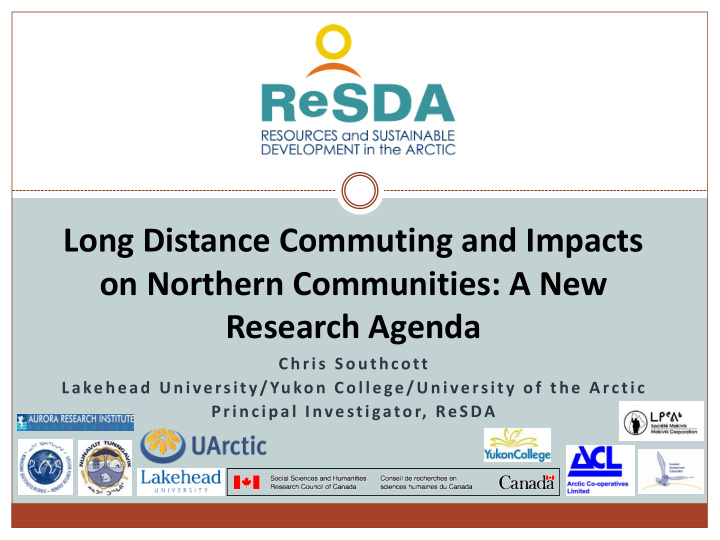



Long Distance Commuting and Impacts on Northern Communities: A New Research Agenda Chris Southcott Lakehead University/Yukon College/University of the Arctic Principal Investigator, ReSDA
Background – Resource Development and Northern Communities “In the past resource development devastated northern communities. People came, disrupted communities, damaged cultures, polluted the land, made money, and then left leaving the communities to clean up the mess.” Giant Mine, Yellowknife NWT
The Central Research Questions Can resources be developed in a manner that helps the long-term sustainability of Arctic communities? How can this be done? How can FIFO be done in a way that contributes to community sustainability? Giant Mine, Yellowknife NWT
First Projects – Gap Analyses Gap Analysis Them e Lead Researcher History of Resource Development Ken Coates, University of Saskatchewan Impacts of Resource Development Peter Schweitzer, University of Vienna; Thierry Rodon, Université Laval Measuring Impacts Andrey Petrov, University of Northern Iowa Resource Revenue Regimes Lee Huskey, University of Alaska Anchorage Social, Economic and Environmental Impact Assessment Bram Noble, University of Saskatchewan Regional Economic Development Frances Abele, Carleton University Social Dimensions of Resource Development Brenda Parlee, University of Alberta Community – Industry Relations Ken Caine, University of Alberta Impact Benefit Agreements Ben Bradshaw, University of Guelph Resources and the Subsistence Economy David Natcher, University of Saskatchewan Traditional knowledge and resource development Henry Huntington, PEW Environment Group Resources and Environmental Issues Arn Keeling, Memorial University Climate Change Chris Southcott, Lakehead University Cross Cutting Theme research: Gender and Resource Development Suzanne Mills, McMaster University; Martha Dowsley, Lakehead University
Initial Findings related to FIFO from a Northern Community Perspective A New FIFO Typology to understand impacts Two types of FIFO – external and internal External FIFO is usually seen as negative Internal FIFO is seen as having both positive and negative impacts Various forms of FIFO Isolated FIFO Staging area FIFO Proximate FIFO
External FIFO Positive aspects Reduction of boom and bust impacts (fluctuations in housing prices, employment fluctuations) Less out-migration Reduction of cultural impacts (especially if workers isolated from locals) Benefits through IBAs Negative aspects No employment benefits to communities No indirect benefits through capacity-building (education and training) No multiplier effect
Internal FIFO Positive Impacts Employment benefits to communities Indirect benefits through capacity-building (education and training) Limited multiplier effect Negative Impacts Impacts on families and youth Drug and alcohol abuse and associated social pathologies Dangers of cultural assimilation Dangers of future out-migration Gender divisions
Isolated Internal FIFO Positive aspects Limited boom and bust impacts (depending on levels of local FIFO employment) Employment benefits to communities Indirect benefits through capacity-building (education and training) Limited cultural impacts Negative aspects Limited multiply effect Impact of families Some drug and alcohol abuse and associated social pathologies High danger of future out-migration
Staging Area Internal FIFO Positive Impacts Increased multiplier effects Negative Impacts Increased danger of boom and bust impacts Increased cultural impacts Increased danger of social pathologies
Proximate External FIFO Positive Impacts Multiplier effect No FIFO for local workers Negative Impacts Boom and bust impacts Strain on local services Cultural impacts Strong possibility of social pathologies Impacts on women
Towards a FIFO research agenda for northern communities ReSDA is be interested in things that directly impact northern communities Host communities and regions Workers from host regions Better understanding of the impacts of FIFO under different situations What are the positive aspects of FIFO and how can these be optimized? What can be done to mitigate negative impacts?
Thank you Merci Qujannamiik Main Contributing Partners for ReSDA The Social Sciences and Humanities Research Council of Canada University of the Arctic The Labrador Institute Newfoundland and Labrador Dept of Labrador and Aboriginal Affairs http://dl1.yukoncollege.yk.ca Makivik Corporation /resda/ Nunavut Research Institute/Nunavut Arctic College Nunavut Tunngavik Inc. Government of Nunavut Aurora Research Institute/Aurora College Inuvialuit Regional Corporation Government of the Northwest Territories Northern Research Institute/Yukon College Yukon Government Canadian Northern Economic Development Agency Indian and Northern Affairs Canada Arctic Cooperatives Conference Board of Canada
Recommend
More recommend